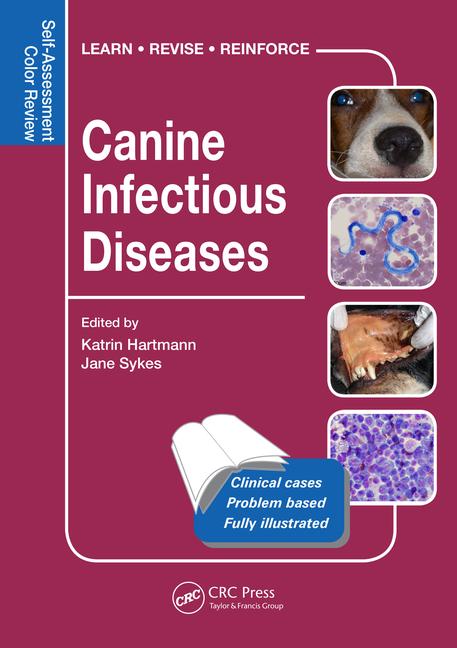Book Review: Hartmann and Syke's ‘Canine Infectious Diseases: Self-Assessment Color Review’
Canine Infectious Diseases is a case-based, self-assessment learning guide aimed at enhancing knowledge and understanding of canine infections for experienced veterinary professionals in practice and veterinary students on clinical rotations. The book contains 201 fully-illustrated clinical cases, describing common bacterial, viral, fungal and parasitic pathogens. The authors, Katrin Hartmann and Jane Sykes, are both highly and appropriately qualified, being diplomates in Small Animal Internal Medicine, and this comes through clearly in the structure and explanation of the clinical cases within the book.
Although the authors have described this book as being predominantly for working vets and students on fourth-year rotations, it is evident that the clinical cases described would additionally aid revision for earlier years of study; when learning general pathology (often in year 2 of the veterinary course), it is useful to relate the lectured theory content into clinical examples. The cases in “Canine Infectious Diseases” provide multiple real-life examples that provide students with details of clinical history, physical examination and gross pathology, as well as images and explanations of the pinnacle histopathology that underpins the majority of second year content. Additional supplementary information is provided where needed, including radiographs, ultrasound images, haematology and biochemistry results, which further allows students who are not currently in clinical years to access and practice interpreting results from core diagnostic procedures earlier on in their degree. Included are photos of gross pathology, histopathology, cytology, radiographs, ultrasound, photos from post-mortem examinations and MRI scans, amongst others. The images used throughout the book are of a high standard, are adequately referenced and enhance each case study with important clinical information.
Questions are included for each case study to allow readers the opportunity to test their understanding of the case and reflect on how it might be approached in practice. The scope of the questions differs between cases, asking readers to think about different topics, such as naming specific pathogens, differential diagnoses, interpretation of provided test results/images and treatment options. This is another example of where the book can be applied to different years of veterinary school. Answers to the questions are provided in the second half of the book and are well-detailed and clearly explained. For example, the answer to question 1 of Case 131 (Parvovirus infection, “‘What supportive treatment is appropriate?’”) is almost a page long and describes multiple key components to aid in recovery of infected animals, including information on how to deliver optimum nutrition and the potential need for blood transfusion. The questions are repeated alongside the answer, making the second-half of the book readable on its own, e.g. at times of quick revision.
Despite loving the book from the beginning, one area where I think Canine Infectious Diseases can be improved is the contents page; though this is helpfully classified into the type of infectious agent, the case numbers are listed alongside the description (e.g. Botulism 81), as opposed to the associated page numbers. In my view, it would be more beneficial to list the page number alongside the case number to avoid confusion. Additionally, I felt that common infectious diseases had been missed from the book. Although there are a huge number of potential canine infectious agents worldwide, I felt that some especially prevalent diseases, seen whilst observing practice and highlighted during lectures, could have been included for completeness. One such example is flea-allergy dermatitis (this is discussed in case 195, but only indirectly as a cause of secondary pyoderma of the skin; no details regarding the causative agent), or Dipylidium caninum infection. Similarly, the addition of cases relating to vaccination might be questioned; although undeniably related to infectious disease (or the prevention of), I wasn’t sure that these fitted in with the rest of the cases. If the book was more extensive, and additional similar disease entities were discussed e.g. complications from other treatments/prophylaxis, then perhaps these would be integrated better.
Overall, I found this book easy to read and extremely useful for revising second-year pathology and relating theory to clinical examples. Many key diseases are described in detail and the use of diagnostic test results, especially histopathology, aids understanding. I will undoubtedly relate to Canine Infectious Diseases throughout the veterinary course, and the size of the handbook additionally makes it ideal for taking to clinical placements. The textbook could be made more extensive to cover the full-range of potential canine infections, which would help establish it as a recognised reference point for vets in practice and during studies. Similar textbooks could be written to study infectious diseases in other species. I would highly recommend Canine Infectious Diseases to any veterinary student with an interest in the subject of infectious disease, or undertaking placements or revision, as well as to graduated veterinary surgeons who may need to reinforce their knowledge.
| This book was reviewed by: Date reviewed: December 2018 |
To purchase the full text with your 20% off discount code, go to the CRC Press Veterinary website and use code VET18.
